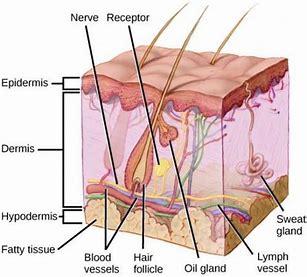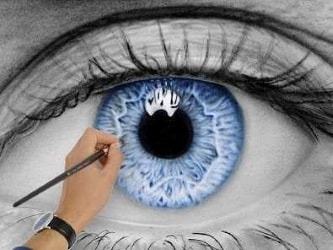Heal:
Anxiety - High Cholesterol - The Gut - The Heart - Inflammation - The Kidneys - The Liver - The Lymphatic System - The Medulla - The Nervous System - The Pancreas - The Pineal Gland - The Reproductive System - The Skin - The Thyroid
Anxiety - High Cholesterol - The Gut - The Heart - Inflammation - The Kidneys - The Liver - The Lymphatic System - The Medulla - The Nervous System - The Pancreas - The Pineal Gland - The Reproductive System - The Skin - The Thyroid
Heal The Skin
The skin is one of the most important – and most neglected – of the eliminative organs. Adults have a skin area estimated at from 2,000 to 3,000 square inches which eliminates about two pounds of waste material per day. The skin has two main layers, called the epidermis or outer layer, and the dermis, a thick underlying layer. The epidermis of the palms of the hands and the soles of the feet have five layers, while the rest of the body has four. Sweat glands, approximately 3,000 per square inch, help control electrolyte and fluid balance in the body and assist in regulating body temperature.
In a healthy skin, the capillaries constantly bring wastes to the sweat glands, which in turn, eliminate them. At the same time, the cells of the epidermis are constantly dying, and, together with the sebaceous glands which produce oil, tend to block the sweat gland openings unless the body is kept clean. Skin brushing with a natural thick bristle brush, neither too soft nor too stiff, is excellent for improving skin elimination. Additionally, our skin needs sunlight and fresh air; and exercise is needed to keep the sweat glands functioning properly. (Bernard Jensen, Iridology, The Science and The Practice in the Healing Arts)
In a healthy skin, the capillaries constantly bring wastes to the sweat glands, which in turn, eliminate them. At the same time, the cells of the epidermis are constantly dying, and, together with the sebaceous glands which produce oil, tend to block the sweat gland openings unless the body is kept clean. Skin brushing with a natural thick bristle brush, neither too soft nor too stiff, is excellent for improving skin elimination. Additionally, our skin needs sunlight and fresh air; and exercise is needed to keep the sweat glands functioning properly. (Bernard Jensen, Iridology, The Science and The Practice in the Healing Arts)

The skin is the primary component of the integumentary system, which is the body's largest organ. It creates a physical barrier between the external and internal environments, providing protection and maintenance. The system encompasses the epidermis, dermis, hypodermis, associated glands, hair, and nails. Beyond its protective role, it has several complex functions, including regulating body temperature, maintaining cell fluid balance, synthesizing Vitamin D, and sensing stimuli. The system's components collaborate to perform these functions. For instance, body temperature is regulated by thermoreceptors that modulate peripheral blood flow, perspiration levels, and the positioning of body hair. The skin is the body’s first line of defense as it acts as the physical barrier that prevents direct entry of pathogens. Cells are interconnected through junction proteins with reinforcement by keratin filaments. Skin sensation is provided by an array of sensory nerve endings that distinguish between pain, temperature, touch, and vibration.
The Skin - 'The Third Kidney'
Among the four elimination pathways – the digestive system with the colon, the urinary system with the kidneys, the respiratory system with the lungs, and the integumentary system with the skin – it is the integumentary system that expels toxins through the skin. The skin acts as a protective yet semi-permeable barrier, allowing or denying certain airborne chemicals entry while also serving as a major exit for toxins.
The skin, the body's largest organ, is part of the integumentary system. Sweating is crucial for removing toxins through the skin, which are often small or gaseous, akin to the lungs' function. The skin is sometimes called "The Third Kidney" because it takes over the role of the kidneys in expelling waste when they are unable to do so. Kidney issues can lead to acute or chronic sweating, also known as excessive sweating. Stress or autonomic nervous system stimulation can cause sweating if the adrenal glands are overactive.
A decrease in sweating, possibly due to compromised skin or thyroid function, may mistakenly indicate improved kidney function. However, this is often not the case; it may indicate that the body is trying but failing to redirect toxins from the kidneys to the skin due to chronic conditions affecting the kidneys, thyroid, or skin itself.
The skin, the body's largest organ, is part of the integumentary system. Sweating is crucial for removing toxins through the skin, which are often small or gaseous, akin to the lungs' function. The skin is sometimes called "The Third Kidney" because it takes over the role of the kidneys in expelling waste when they are unable to do so. Kidney issues can lead to acute or chronic sweating, also known as excessive sweating. Stress or autonomic nervous system stimulation can cause sweating if the adrenal glands are overactive.
A decrease in sweating, possibly due to compromised skin or thyroid function, may mistakenly indicate improved kidney function. However, this is often not the case; it may indicate that the body is trying but failing to redirect toxins from the kidneys to the skin due to chronic conditions affecting the kidneys, thyroid, or skin itself.
Thank God for excessive sweating, because if you didn’t, you’d be in so much more trouble. With excessive sweating you want to turn your attention to the kidneys. Because your body compensates for what isn’t being done in another area. When the kidneys aren’t filtering, your body has to have a battle plan. Systemic acids aren’t being eliminated out of the kidneys…what is the largest kidney? The skin. (Dr. Morse)
The Skin - What Harms It
The skin is a two-way membrane allowing an exchange of moisture and gaseous vapors in and out of the body. Toxic materials such as solvents, fixatives, paints, and other chemical liquids and gasses can penetrate the skin and cause problems. The skin is an important eliminative organ, just like the bowel, kidneys, and lungs. Heavy. close-fitting clothing prevents the skin from eliminating properly. (Bernard Jensen, Iridology, The Science and The Practice in the Healing Arts)
The Skin - What Heals It
If you have hypothyroidism, which 60 to 70 percent of the population does, you will have a difficult time perspiring. The thyroid gland affects one’s ability to sweat, either making you sweat too much or not enough. Lack of exercise and low activity is another reason people do not sweat enough. Cold-sheet treatments and dry skin brushing are just two simple ways to increase skin elimination. A raw food diet is just as essential to great skin health as it is for the health of any cell. When your skin begins to prolapse (drop) or wrinkle, this is not old age. This is skin weakness. You must care for your skin as you would any vital organ. Remember that the thyroid and liver are related to the skin, so detoxify the liver and keep your thyroid functioning properly. (Dr. Morse, The Detox Miracle Sourcebook)
The Skin - As Seen in the Iris
Iris Signs: 'Scurf Rim,' 'Skin Ring'
Location: Outer periphery of iris adjacent to the sclera.
Indicates: Toxic encumbrance of the eliminative ski n tissue to the degree of darkness and depth of the sign. Poorly eliminating skin and metabolic imbalance due to a lack of silicon.
The skin circulation area is in Zone 7, and the skin itself is represented by the outer circumference of this zone. Experience demonstrates that the skin and circulatory system interact in important ways and that both are profoundly affected by reflexes from the various organs of the body. If the skin is not eliminating properly, the blood and lymph must carry away an extra burden of toxins, and this, in turn, places an extra burden on the kidneys. At all times you must keep in mind how each organ, gland, and tissue affects the whole system of the human organism and, conversely, how the whole system affects each part.
The scurf rim around the perimeter of the iris provides information about the condition of the skin and the blood vessels just beneath it. The presence of a scurf rim shows an accumulation of toxic material due to poor elimination from the skin. Among those with the poorest skin elimination, the scurf rim becomes almost black: while a dense, dark, and wide scarf rim indicates an excessively toxic body, overburden with wastes.
If the scurf rim appears darker over the lungs, we know that poor skin elimination has contributed to an overload of toxic material there, and the same is true for other organs. It may also indicate a suppressed condition in an organ. For example, a dark scurf rim in the feet area of the irides may be the result of efforts to suppress foot perspiration. Suntan oils, deodorants, and other chemical substances used on the skin promote scurf rim by blocking the sweat glands. (Bernard Jensen, Iridology, The Science and The Practice in the Healing Arts)
Location: Outer periphery of iris adjacent to the sclera.
Indicates: Toxic encumbrance of the eliminative ski n tissue to the degree of darkness and depth of the sign. Poorly eliminating skin and metabolic imbalance due to a lack of silicon.
The skin circulation area is in Zone 7, and the skin itself is represented by the outer circumference of this zone. Experience demonstrates that the skin and circulatory system interact in important ways and that both are profoundly affected by reflexes from the various organs of the body. If the skin is not eliminating properly, the blood and lymph must carry away an extra burden of toxins, and this, in turn, places an extra burden on the kidneys. At all times you must keep in mind how each organ, gland, and tissue affects the whole system of the human organism and, conversely, how the whole system affects each part.
The scurf rim around the perimeter of the iris provides information about the condition of the skin and the blood vessels just beneath it. The presence of a scurf rim shows an accumulation of toxic material due to poor elimination from the skin. Among those with the poorest skin elimination, the scurf rim becomes almost black: while a dense, dark, and wide scarf rim indicates an excessively toxic body, overburden with wastes.
If the scurf rim appears darker over the lungs, we know that poor skin elimination has contributed to an overload of toxic material there, and the same is true for other organs. It may also indicate a suppressed condition in an organ. For example, a dark scurf rim in the feet area of the irides may be the result of efforts to suppress foot perspiration. Suntan oils, deodorants, and other chemical substances used on the skin promote scurf rim by blocking the sweat glands. (Bernard Jensen, Iridology, The Science and The Practice in the Healing Arts)




